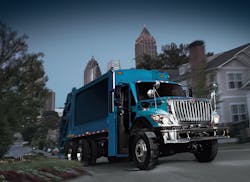Truck and engine maker Navistar posted a $172 million loss for the second quarter on $3.2 billion in revenues, which includes pre-existing warranty charges of $104 million related to 2010 emission standard engines, asset impairment charges of $38 million, engineering integration costs of $29 million, a charge of $10 million for non-conformance penalties for truck engines that do not meet the Environmental Protection Agency’s (EPA) 2010 oxides of nitrogen (NOx) standard.
“Certainly, our first half performance was unacceptable. It included a warranty reserve to repair early 2010 and 2011 vehicles,” noted Daniel Ustian, Navistar’s chairman, president and CEO, in the company’s earnings report. “We were also affected by speculation surrounding our engine certification for our Class 8 engine, which is why we are working tirelessly with the EPA to get resolution.”
Sandeep Kar, global director-commercial vehicle research for consulting firm Frost & Sullivan, emphasized that that getting its heavy-duty truck engines certified by the EPA is the most immediate issue Navistar needs to address.
“Overall, this company seems to be going through short-term pain, but the outlook based on its growth strategies seems one of long-term gain,” he explained in a research brief. “[But] Navistar urgently needs to solve the 13-liter certification issue and place a greater focus on the important issue of global market share growth. At the end of the day, that will deliver share holder value more than anything else.”
Analyst Walter Liptak with Barrington Research added that despite macroeconomic worries, the fundamentals of the trucking business remain strong and should continue to foster demand for equipment.
“Truck orders remain down 23% year-over-year and down 25% quarter to quarter, but the sequential 5% improvement in May [heavy duty truck orders] compared to April is evidence that the bottom is not falling out for the truck sector,” he explained in a recent industry brief.
“Trucker fundamentals are good especially when we look at trucker net profit and cash flow margins [and] the low order cancellation rate and trucker data, including moderating tonnage numbers, suggest to us that the underlying truck sector is healthy,” he pointed out. “Freight activity, while not robust, is continuing to experience modest growth.”
Liptak also believes the second half of 2012 could be a better order period for the truck sector. “We doubt that the May [truck order] data will be enough to turn the cycle more positive, but production rates remain high and second half order improvement could result in 2013 production growth,” he explained.
Those factoids also underlay Navistar’s expectations for fiscal improvement in the second half of the year.
"Going forward, we've identified a path for delivering strong profits in the second half of 2012," noted Navistar’s Ustian in the company’s earnings report. “Historically, the second half is stronger across our businesses, and we expect to build on this with improved market share in North America, stronger global performance and further cost reductions across all operations.”
To that end, Ustian said Navistar is making changes to its management team and operational structure to, in his words, “align our organization in a more effective manner to drive these results.”
For starters, Troy Clarke, currently president of Navistar Asia Pacific, will assume responsibility for all Navistar's operations in the newly-created role of president-truck and engine; heading up a division that will integrate the company’s truck, engine, parts, product development and purchasing organizations.
Jack Allen will shift positions to become president of North America Truck and Parts, an expansion of his current role, while Eric Tech, currently president of the company’s Engine Group will expand his role to become president of its Global Truck and Engine division – responsible for all of Navistar’s business operations outside of North America.
Ustian stressed those changes will take effect July 1 and following approval by Navistar’s board of directors.
Frost & Sullivan’s Kar added that expanding international truck and engine sales volume should become another critical piece of Navistar’s strategic effort to return to profitability.
“Navistar continues to face some headwinds, [yet] despite battling a range of arduous challenges ranging from engine related fines to market share loss caused by reliance on cooled-exhaust gas recirculation (EGR), this is a company whose growth strategies are poised to take it to higher growth gradient in coming months,” Kar explained.
“Navistar's reliance on cooled-EGR as opposed to selective catalytic reduction (SCR), I believe, could yield rich dividends and volume, as well as, market share growth in key markets such as China and India,” he pointed out. “While it is true Brazil is slowing down and China could potentially deliver lackluster growth, the strategies, plans and products Navistar is putting into place hold the potential of multiplying its growth as the global economy starts to bounce back from recession.”
